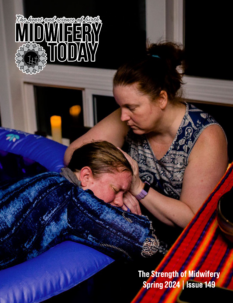
First, Do No Harm to Newborns
Editor’s note: This article first appeared in Midwifery Today, Issue 116, Winter 2015.
Subscribe to Midwifery Today Magazine

Jan Tritten and Baby Makar
Photo provided by the author
Babies should be treated with the utmost respect, dignity and love. Their first birth minutes are their welcome to the planet. This is where they will first learn what being on earth is all about. They are most often, hopefully, in a gentle birth whether at home or in hospital, welcomed in tenderness. I would optimistically like to think most are. Any one of us privileged to be at a birth—a family’s sacred moment—is honored to be there. Honoring mother and baby is our deepest responsibility.
I just tweeted: All babies deserve love and respect at birth and beyond. Do not mess with the baby’s home … the mom! The important thing to remember is that whatever is done to the mom is done to the baby. When s/he comes out, whatever is done to the baby is ultimately done to the mom. Mom will need to deal with whatever trauma the baby receives; she may not even know what happened to cause the trauma.
Knowing what we know, we allow time for the baby to receive all of her blood by not clamping or severing the cord before the placenta has stopped pulsating. The baby belongs with the mom. Midwife Carla Hartley’s saying, “No hatting, chatting or patting,” shows great respect for the newborn. Patting can sometimes turn brutal.
I was recently sent a video showing a homebirth midwife literally beating on a baby who was just a few seconds old. This baby had been resting gently on his mother’s chest shortly after the birth; the parents were shedding tears of joy. Then, for some unknown reason, the midwife began beating on the baby’s back hard enough that Gail Hart and I were calling it child abuse. This baby was nowhere near a minute old. If I had given the baby an Apgar score before this scene happened, I would have given the baby a 10. He had great color, flexion and muscle tone, so the heart and lungs were working otherwise these signs would not have been so good. Now what was that homebirth midwife taught that she would do something this cruel to this baby and probably all whom she midwives? We might expect rougher treatment in a hospital in the 1950s but not at home today.
It makes me really question what is taught to midwives. I would think that anyone going through midwifery school would have been assigned to read some of the classics such as Gentle Birth Choices by Barbara Harper and Spiritual Midwifery by Ina May Gaskin. It is discouraging for me, and for everyone who has dedicated their lives to spreading excellent midwifery skills, to hear that things like this are still happening in the world today. I thought midwife-attended births was the answer to so many of our social problems but that is only the case if the midwives are taught properly. If we cannot trust midwives to carry the future, who can we trust?
Can we begin again to love and respect all newborns at their birth? Leave the cord intact so they get all their blood. Keep quiet if all is well so the family can bond with their newborn without our intrusion. And always remember to first, do no harm.
Toward better birth,
Jan

 Jan Tritten is the founder, editor, and mother of Midwifery Today magazine and conferences. Her love for and study of midwifery sprang from the beautiful homebirth of her second daughter—after a disappointing, medicalized first birth in the hospital. After giving birth at home, she kept studying birth books because, “she thought there was something more here.” She became a homebirth midwife in 1977 and continued helping moms who wanted a better birth experience. Jan started Midwifery Today in 1986 to spread the good word about midwifery care, using her experience to guide editorial and conferences. Her mission is to make loving midwifery care the norm for birthing women and their babies in the United States and around the world. Meet Jan at our
Jan Tritten is the founder, editor, and mother of Midwifery Today magazine and conferences. Her love for and study of midwifery sprang from the beautiful homebirth of her second daughter—after a disappointing, medicalized first birth in the hospital. After giving birth at home, she kept studying birth books because, “she thought there was something more here.” She became a homebirth midwife in 1977 and continued helping moms who wanted a better birth experience. Jan started Midwifery Today in 1986 to spread the good word about midwifery care, using her experience to guide editorial and conferences. Her mission is to make loving midwifery care the norm for birthing women and their babies in the United States and around the world. Meet Jan at our 
















